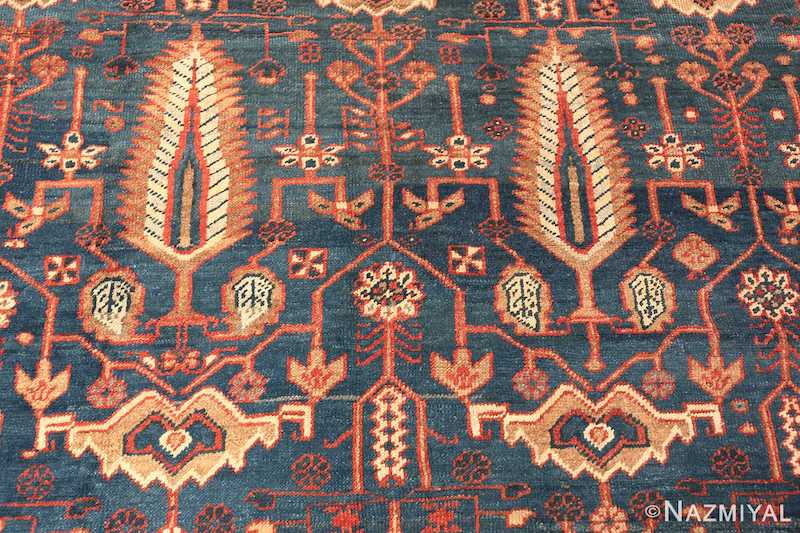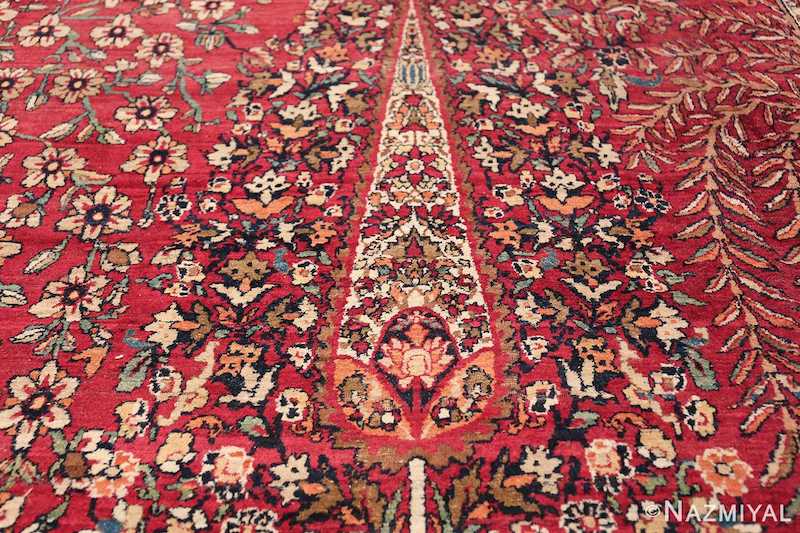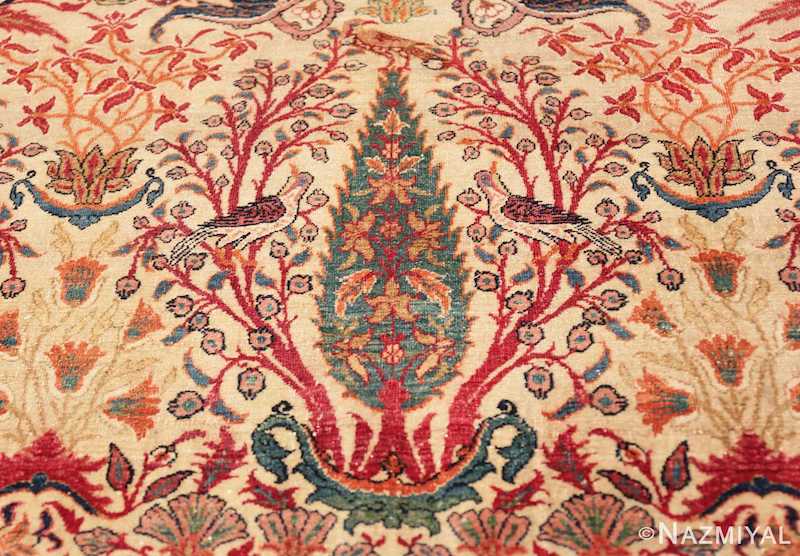Antique Rug Symbols: Cypress Trees
Click Here to Go Back to List of Symbols
What is a Cypress Tree?
A Cypress tree is a type of coniferous tree belonging to the family Cupressaceae. These trees are known for their tall, slender shape, and their branches typically grow in a pyramid-like fashion. Cypress trees are found in various regions around the world and are especially prevalent in areas with mild, Mediterranean climates.
Here are some key characteristics of Cypress trees:
- Appearance: Cypress trees typically have scale-like or needle-like leaves that are arranged in an opposite or whorled pattern along the branches. The foliage is often dark green or bluish-green in color. The bark of mature Cypress trees is usually reddish-brown or gray and becomes fibrous and furrowed over time.
- Size: Cypress trees can vary in size depending on the species. Some species, such as the Mediterranean Cypress (Cupressus sempervirens), can grow up to 100 feet (30 meters) tall, while others are smaller and more shrub-like.
- Habitat: Cypress trees thrive in various environments, including wetlands, swamps, and coastal areas. They are well adapted to tolerate both wet and dry conditions. Some notable Cypress tree species include the Bald Cypress (Taxodium distichum), Monterey Cypress (Cupressus macrocarpa), and Leyland Cypress (× Cuprocyparis leylandii).
- Uses: Cypress trees have been valued for their wood, which is durable, rot-resistant, and often used for construction purposes, including outdoor furniture, boats, and building materials. Additionally, Cypress trees are often planted as ornamental trees in gardens and parks due to their elegant appearance.
- Symbolism: Cypress trees have cultural and symbolic significance in various traditions. They are associated with longevity, endurance, and mourning in some cultures. In ancient mythology, Cypress trees were often linked to the realm of the dead and were planted near cemeteries or used to construct burial monuments.
Overall, Cypress trees are admired for their graceful appearance, adaptability to different environments, and the usefulness of their wood.

The Cypress Tree
What is a Cypress Tree Design Motif?
Cypress trees are evergreens, and are a commonly used motif in art in Asia Minor. The cypress is depicted as a variation of the tree of life motif, which represents everlasting life. The cypress is used in rituals with the dead, but symbolizes the eternal life that comes after death.
The cypress was the most popular tree used in Persian gardens, and accordingly, was represented in garden carpets. The oldest known living cypress in the world is 4000 years old, in Yazd Province, Iran. Representations in Anatolian and Caucasian weaving are geometric while Persian representations are more naturally portrayed.
The Majestic Cypress Tree Motif
The cypress tree is one of the most beautiful motifs that you can find in Persian rugs. It is common in garden-themed carpets where it alludes to the tall cypress trees that once graced the formal palace gardens of the Persian Empire. Their majestic presence reaches towards the heavens in Persian carpets just as they did in these ancient garden paradises. The cypress tree motif is one that has roots that go all the way back to the roots of Persian civilization itself.
A Symbol with Ancient Roots
The cypress tree motif is one that has its beginnings in the Sassanian culture between 224-651 CE. The Sassanians occupied the land that would later become Persia and modern-day Iran. The success of this empire was greatly influenced by the social stratification that was reinforced by the Zoroastrian religion. The culture was also influenced by both ancient Greek and Roman culture.
It is believed that Zoroastrianism originated in the ancient traditions that predate its first formal writings and teachings. Zoroastrian religion’s most ancient form of worship entailed open-air gatherings, usually on a high mountain. It involved an urn with a fire that was flanked by two cypress trees reaching towards the sky.
In later practice, the temple ceremonies were held in structures that were built for that purpose. However, cypress branches were often burned or placed on the altar and still plays an important role in the ceremony.
The cypress tree is the symbol for eternity and for long life. It frequently appears in Zoroastrian folk art. There are several reasons for this. First, the cypress tree is an evergreen and does not die back in the winter but stays green all year. Secondly, cypress trees are known as some of the longest-lived trees in the world.

Cypress trees on a Persian Bakshaish rug.
The Zoroastrian word for tree is the same as the word for “immortality’ and references a life without death or the continuation of life beyond the grave. It is found throughout Zoroastrian poetry in association with prophetic vision or oracles.
One of the most sacred sites in Zoroastrianism is on the Uber Mountain in central Iran. This mountain is the home of an ancient Cypress tree that is said to have witnessed the dawn of Zoroastrianism and the most ancient Persian culture. It is known as the Cypress of Kashmar and is believed to be around 4,000 years old.
In Zoroastrianism, cutting down a cypress tree is believed to be bad luck. It is said that when you cut down a cypress tree, you cut your own fortune and open yourself to illness or misfortune. Cypress trees were planted around temples and were used to shade the graves of people of religious importance. The cypress tree is one of the most important symbols in Zoroastrianism.
Decline of Zoroasatrianism
It is not surprising that the cypress tree appears prevalently in Persian art, going back to the most primitive cultures to inhabit the land. Cypress trees are revered and respected, even today. They are a common site in formal gardens and in many forms of art, including pottery, painting, and carpets.
Zoroastrianism was the dominant religion in Persia up until the Middle Ages. The Sassanid rulers considered the Christian Roman Empire to be an arch-rival, which eventually led to persecution by Christians and the destruction of many Zoroastrian symbols. Zoroastrianism is a tolerant religion and did not exclude other ideas and viewpoints. In the 7th century, the Sassanids were overthrown by Umayyad Caliphate and Islam. The Zoroastrians were so numerous that the Islamic rulers decided to co-exist rather than to try to convert them. Zoroastrian symbols are still common in artwork from this time and can sometimes be found alongside Islamic art.
Throughout the Middle Ages, there was a slow conversion of Zoroastrians to Islam. In the beginning, this was done through social advantage, rather than by force. There were still pockets that remained true to Zoroastrianism. Many of the practices of Zoroastrian practices defy the traditions of Islam. Eventually, social pressure was placed on those who continued to practice Zoroastrianism in Islamic centers, and they were forced to move to areas where Zoroastrianism was more prevalent. This resulted in pockets where Zoroastrianism continued to thrive, along with its ancient symbols and motifs.
This is an important concept to understand when it comes to understanding the significance of the Cypress tree motifs in Persian rugs. In areas where Zoroastrian died out, so did the symbols associated with it. However, the cypress tree continued to be a prevalent motif in many parts of Persia, particularly throughout the 15th and 16th centuries.

A cypress tree in a Persian Kerman rug.
Cypress Trees in Persian Carpets
When you see a cypress tree in a Persian rug, it is an important clue as to the cultural heritage of the people who created it. It some areas where Islamic law was strictly enforced, Zoroastrian symbols were outlawed. However, this only occurs in pockets, and you cannot say this was the case across all of Persia. It depended on the sentiments of the local leader. The cypress tree is a clue that the weaver was honoring the ancient traditions of Zoroastrianism that predate both Christianity and Islam. In some cases, it might be a way to invoke the feelings of the formal gardens of the Safavid rulers and palace gardens.
The cypress tree motif makes a majestic statement in the design of Persian carpets. It is universally understood as a symbol that represents eternal youth and life beyond death. Sometimes, you will find them used to provide structure and direction in the design. They make a statement in the carpet design as much as they do in the garden. You can often find them alongside tree of life and other nature-inspired themes.
Why are Cypress trees called “Cypress” trees?
Cypress trees are called “Cypress” due to their association with an ancient Mediterranean island called Cyprus (pronounced ‘sigh-prus’). The name “Cypress” is derived from the Latin word “Cupressus,” which itself is believed to have originated from the Greek word “kyparissos.” The Greek word referred to the island of Cyprus, where these trees were abundant.
In ancient times, Cypress trees were prevalent on the island of Cyprus, and they played a significant role in the region’s culture and economy. The wood from these trees was highly valued for its durability and was used in various construction and decorative applications. Additionally, Cypress trees were associated with religious and mystical significance in ancient Greek and Roman mythology.
Over time, the name “Cypress” became the common term used to refer to these distinctive coniferous trees found not only on Cyprus but also in other parts of the world. Therefore, the name “Cypress” serves as a historical reminder of their origins and their close connection to the island of Cyprus.
Enjoy your stroll through our garden of cypress tree motif carpets. Perhaps you will find one to inspire your own interior paradise.

